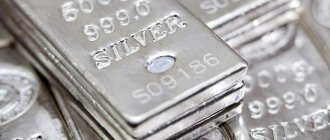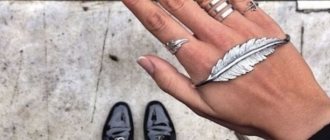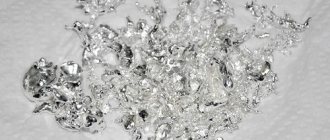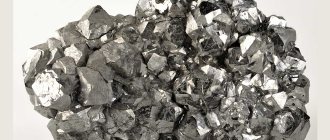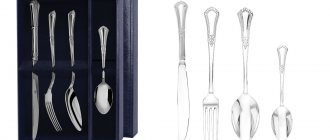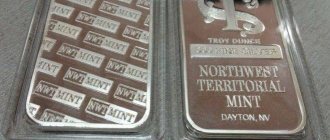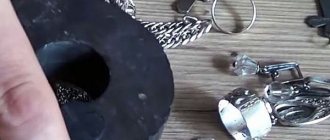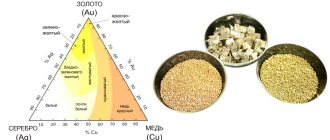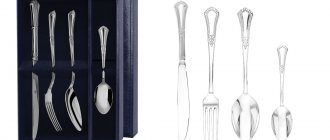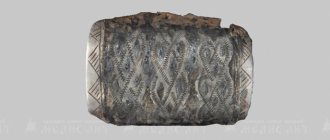Silver is one of the rare elements that form the group of precious or noble metals. This group also includes gold, platinum and five platinum group metals.
Like all noble metals, silver under normal conditions is not exposed to air, water, or any other factors that usually lead to rapid corrosion and oxidation of “ordinary” metals. In addition, silver is quite rare in the earth’s crust and has a number of other remarkable properties, which classifies it as a precious metal.
Silver oxide Ag2O
The black-brown color can be obtained by introducing an alkali into a solution containing Ag⁺ ions. First, apparently, a hydroxide is formed, which immediately turns into an oxide:
Ag⁺ + OH⁻ = AgOH;
2AgOH = Ag2O + H2O.
Although silver oxide is a poorly soluble compound in water, its aqueous suspension has a clearly defined basic reaction, therefore silver salts in aqueous solutions do not hydrolyze and give a neutral reaction. When heated to 185-190°C, Ag2O decomposes into elements. Hydrogen peroxide is easily reduced by Ag2O already at room temperature:
Ag2O + H2O2 = 2Ag + H2O + O2.
Ag2O dissolves in an aqueous solution of ammonia to form a complex compound:
Ag2O + 4NH4ОH = 2Ag(NH3)2OH + 3H2О.
When standing, a precipitate of silver nitride Ag3N (silver fulminate), which is extremely explosive even when wet, precipitates from the solution.
Application
The phenomenon of photodissociation of silver bromide is used in photography (in black and white or in a mixture with sensitizers in color). Silver bromide is also used to create special glasses that change their transparency under different lighting conditions. When glass with an admixture of silver bromide is irradiated, the latter decomposes with the formation of fine particles of silver - the glass darkens. In the dark, the reverse process occurs (because free bromine is not able to leave the resulting cavities in the glass) and the glass becomes transparent again.
Silver halides
Slightly soluble compounds. The only exception is the readily soluble fluoride AgF. AgCl chloride, AgBr bromide and AgI iodide precipitate when Cl⁻, Br⁻ and I⁻ ions are introduced into a solution containing Ag⁺ ions (for example, an AgNO3 solution). Their solubility products are respectively 1.8 • 10⁻¹º (AgCI), 5.3 • 10⁻¹³ (AgBr) and 8.3 • 10⁻¹⁷ (AgI).
In hydrometallurgy and the refining of precious metals, the method of precipitation of silver in the form of chloride, carried out by introducing NaCl or HCl into silver-containing solutions, is widely used. Silver chloride melts at 455°C. The boiling point of AgCl is 1550°C, but noticeable volatilization is observed already at temperatures above 1000°C.
Silver ions form strong complexes with a number of ions and molecules (CN⁻, S2O²3⁻, SO²3⁻ Cl⁻, NH3, CS(NH2)2, etc.). Due to this, AgCl, which is practically insoluble in water, easily dissolves in aqueous solutions of potassium cyanide, sodium thiosulfate and sulfite, ammonia, for example:
AgCl + 2CN⁻ = Ag (CN)F + Cl⁻;
AgCl + 2S2C²3⁻ = Ag (S2O2)³2⁻ + Cl⁻;
AgCl + 2NH4OH = Ag(NH3)2+ + Cl⁻ + 2H2O.
Due to the formation of complexes with Cl³⁻ ions, silver chloride is also noticeably soluble in concentrated hydrochloric acid and solutions of other chlorides:
AgCl + Cl⁻ = AgCl⁻ 2.
For example, in a concentrated solution of NaCl, the solubility of silver chloride is 6.7•10³⁻mol/l (0.72 g/l Ag) versus 1.3•10⁻⁵ in water. Concentrated NaCl solutions were previously used for leaching silver from chlorinating roasting cinders.
Thus, when chlorine ions are introduced into silver-containing solutions, the concentration of silver first falls (formation of AgCl) and then begins to increase (as a result of complexation). Therefore, to achieve complete silver deposition, a large excess of chlorine ions should be avoided.
By electronegative metals (zinc, iron), silver chloride, taken in the form of a suspension in dilute sulfuric acid, is easily reduced to metal. This simple technique for obtaining metallic silver from its chloride is widely used in refining. Silver bromide AgBr is similar in properties to AgCl. It is soluble in ammonia, thiosulfate, sulfite and cyanide solutions, and is easily reduced to metal.
Molecular and crystal structure
Crystal structure of AgCl
Silver chloride has the following elemental composition: Ag (75.26%), Cl (24.74%). The silver atom in the molecule is in the sp3d2
-hybridization.
Bond breaking energy in the compound ( Eb
): 313 kJ/mol, Ag-Cl bond length: 0.228 nm.
AgCl crystals belong to the cubic system, NaCl type structure, space group Fm3m
, unit cell parameters
a
= 0.5549 nm,
Z
= 4. The central atom forms an octahedron with its neighbors, the coordination number is 6.
In the gas phase, silver chloride exists in the form of monomer, dimer and trimer.
AgI iodide
The least soluble of the silver halides, therefore, unlike AgCl and AgBr, it is not soluble in ammonia solutions, but is soluble in the presence of CN⁻ and S2O²3⁻ ions, with which silver forms complexes that are stronger than with ammonia. AgI also has noticeable solubility in concentrated solutions of alkali metal iodides, which is explained by the formation of complex ions AgI⁻2.
A very characteristic and important feature of sparingly soluble silver halides is their sensitivity to light, which consists in the fact that under the influence of light they decompose into metallic silver and free halide:
2AgG=2Ag+G2
This property of silver halide salts underlies their use for the production of photographic materials - photosensitive films, plates and paper. The photosensitivity of silver halides increases in the AgI series
Cyanide AgCN is very similar in properties to silver halides. It precipitates as a white precipitate when a solution of alkali metal cyanide (without excess) is added to a solution containing Ag⁺ ions. Like silver halides, AgCN is practically insoluble in water (solubility product 2.3•10⁻¹⁶) and dilute acids, but soluble in ammonia, thiosulfate and cyanide solutions due to the formation of the corresponding complex compounds. Unlike halides, silver cyanide does not decompose when exposed to light.
Sulfuric ointment
You can check the authenticity of silver at home using sulfur ointment (sold in pharmacies).
Apply the ointment to a small area of the product and wait 2 hours. Remove it from the surface with a dry cloth and carefully inspect the treated area: if the surface has darkened, this is silver; if it has acquired a different shade or remains unchanged, the product is made of a different metal.
The test with sulfur ointment is also carried out in another way: a small area of the product is rubbed with fine-grained sandpaper and lubricated with sulfur ointment. After 15 minutes, the result is assessed. If there is a dark spot left on the treated area, then there is a high probability that this is real silver. Metals such as nickel or stainless steel will not interact with sulfur ointment, and, accordingly, no stains will remain on the product.
To remove dark spots left after sulfur ointment, you can wipe the product with ammonia or put it in a soda solution.
Silver nitrate
Among other silver compounds, silver nitrate and silver sulfate are of great practical importance.
Silver nitrate AgNO3 is obtained by the action of nitric acid on metallic silver:
3Ag + 4HNO3 = 3AgNO3 + NO + 2H2O.
Silver nitrate is colorless, non-hygroscopic crystals, melting at 208.5 °C; at temperatures above 350 °C it thermally decomposes. AgNO3 dissolves very easily in water. At 20 °C its solubility is 222 g per 100 g of water, at 100 °C it increases to 952 g per 100 g. In the presence of organic substances, silver nitrate turns black due to partial reduction to metal.
Silver nitrate is technically the most important compound of this metal. This salt serves as the starting product for the preparation of other silver compounds. An aqueous solution of AgNO3 is used as an electrolyte in the electrolytic refining of silver.
Work order
Actions to be taken:
- prepare a melting pot from a spoon;
- treat it with flux;
- heat the mixture until it transforms into a melt state.
To make a smelter, you need to cut 4 rectangles from an asbestos sheet. One should be larger than a spoon, the other should be its size, the next one should be half the size of the second, the last one should be even smaller. Wet asbestos rectangles with water until they soften. Place the smallest rectangle on the bottom of the melting spoon. Cover it with a larger plate on top. Place an even larger piece on it. Smooth each layer well with your fingers. The largest rectangle wraps the edges of the spoon completely around the perimeter along with the base of the handle. The entire structure is thoroughly crimped again. It turns out something like a shallow crucible. You can form a small groove at one edge to drain the molten metal.
The improvised smelter should dry well and harden.
Batch preparation. On an accurate scale you need to weigh out 20 g of scrap silver. Use a magnet to remove possible iron and steel particles.
Next comes the processing of the melting spoon with flux. Flux is needed to remove various oxides from the melt and to protect the melt from oxygen entering it. Borax is used as a flux. 1 part of flux is consumed for 10 parts of the charge of the same weight.
Place the dried spoon in a horizontal position and pour borax into it. Light the gas or gasoline burner and adjust the flame. It must be very soft so that the flux does not fly away in all directions. You need to heat the flux until it turns into a greenish honey-like mass. Open the air supply to the burner to make the flame harder and more powerful. Load a spoon with the mixture, putting 20 g of scrap silver in it. Heat the mixture until it turns red, melts and drips to the bottom of the spoon. Properly melted silver should shine. If its surface is covered with an oxide film (cloudy), then it has not yet melted.
Completely molten silver is like a small puddle of mercury. It can be poured into any form, preheated and lubricated with wax. The temperature of molten silver is about 950 degrees. The asbestos coating of the smelter can withstand 4-5 heats, then it will have to be changed. If melting fails, cool the ingot and repeat the whole process again.
Silver sulfate Ag2SO4
Can be prepared by dissolving metallic silver in hot concentrated sulfuric acid:
2Ag + 2H2SO4 = Ag2SO4 + SO2 + 2H2O.
Silver sulfate forms colorless crystals that melt at 660°C. At temperatures above 1000°C it thermally decomposes. The solubility of Ag2SO4 in water is low; at 25°C it is 0.80 g per 100 g of water. In concentrated sulfuric acid, the solubility is much higher due to the formation of more soluble bisulfate AgHSO4.
Silver sulfide Ag2S is the most difficult to dissolve salt of this metal (solubility product 6.3 • 10⁻⁵º). It precipitates as a black precipitate when hydrogen sulfide is passed through solutions of silver salts. The formation of Ag2S also occurs when H2S acts on metallic silver in the presence of moisture and atmospheric oxygen;
4Ag + 2H2S + O2 = 2Ag2S + 2H2O
As noted, this process is the cause of darkening of silver items during long-term storage. Silver sulfide can also be obtained directly from the elements by heating metallic silver with elemental sulfur.
Ag2S dissolves in cyanide solutions as a result of the formation of a complex compound:
Ag2S + 4CN⁻ ⇄ 2Ag(CN)⁻2 + S²⁻
This reaction is reversible; its progression from left to right is facilitated by an increase in the concentration of CN⁻ ions and the removal of S²⁻ ions by their oxidation with the oxygen of the blown air.
Ag2S does not interact with dilute mineral acids. Concentrated sulfuric and nitric acid oxidize silver sulfide to sulfate. When heated in air, Ag2S decomposes to form metallic silver and sulfur dioxide:
Ag2S + O2 = 2Ag + SO2
Of the previously mentioned complex compounds of silver, the most interesting for the hydrometallurgy of this metal are the highly soluble complex cyanide compounds of potassium, sodium and calcium. Like similar gold compounds, complex silver cyanides are formed by dissolving metallic silver in a solution of the corresponding cyanide with access to atmospheric oxygen:
4Ag + 8CN⁻ + O2 + 2H2O = 4Ag(CN)7 + 4OH⁻
This reaction, like a similar reaction with gold, underlies the cyanidation process. Like gold, silver dissolves in aqueous solutions of thiourea in the presence of Fe(III) salts, forming complex cations Ag[CS(NH2)2]⁺2
An article on the chemical properties of silver
Magnet
Silver, like gold, is diamagnetic, so you can quickly check its authenticity using a magnet.
Bring a magnet to the item - if it is magnetic, it means that it is either a silver-plated item or made of another metal. If the item is not magnetic, there is a very high chance that it is real silver.
Testing with a magnet may not give the desired result if the main alloy material is copper. So, cupronickel and brass (copper alloys) will not be attracted to a magnet
